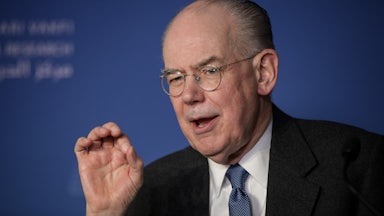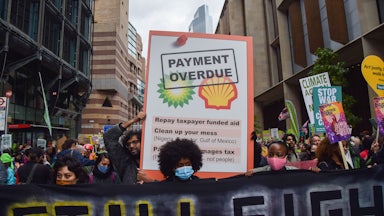CERAWeek 2022 by S&P Global, this year’s annual confab for oil and gas executives, features a lot of two things: reverent references to the crisis in Ukraine and campy energy-themed rewrites of Broadway showtunes. And one rewrite in particular, on Tuesday, seemed to capture the industry’s relief at its change in fortunes, judging by the laughs it got in the Hilton ballroom where attendees gathered Tuesday night: “Don’t cry for me hydrocarbons.”
Hours earlier, as the second day of CERAWeek got started in Houston on Tuesday, President Biden announced that he would ban Russian energy imports to the United States. “Russian oil,” he said, “will no longer be acceptable at U.S. ports, and the American people will deal another powerful blow to Putin’s war machine.” The U.K. followed suit.
If news of the oil ban landed lightly at the fortieth annual CERAWeek (both the U.S. and the U.K. get relatively little oil from Russia), it’s only because of how much has recently changed for the industry. In 2020, oil and gas crashed hard due to the pandemic. And even with the big infusions of government cash that followed, the industry was bracing to navigate a world of net-zero pledges and rising concerns about its products’ destructiveness. Now, thanks to Putin’s invasion and a massive humanitarian crisis, “energy independence”—the old Nixon-era talking point—is back, and it’s good for business.
Before the invasion, for instance, it would have been difficult to imagine the rapid bipartisan push for an import ban that my colleague Grace Segers reported on this week. The White House had initially refused to include energy in its sweeping sanctions program for Russia before bowing to a coalition that included the likes of Nancy Pelosi and Lisa Murkowski. It’s possible that there’s some canny politicking at play from the White House: With support in Congress and from voters, the ban allows it to sell high gas prices as a patriotic imperative. The White House’s support for the ban could also help it coax Joe Manchin—one of the first to come out for a ban—into supporting the Build Back Better provisions still floundering in the Senate.
“It’s a great political strategy,” George David Banks, a member of the State Department’s negotiating team at the U.N. Framework Convention on Climate Change under Trump and now a nonresident Senior Fellow at the Atlantic Council, told me when asked about the bipartisan push that seems to have changed the White House’s mind. “It’s way too attractive right now.”
The oil ban is a relatively easy measure, as Banks and several other CERAWeek attendees pointed out, because Russian oil is a drop in the bucket in the country’s oil supply. Reaction to the announcement at the conference was accordingly muted. At a panel on the outlook for oil markets (“Turbulence or Stability?”) ConocoPhillips chief economist Helen Currie offered a measured assessment. While it’s “the right thing to do policywise,” she said, “I don’t think it makes that big of a difference,” specifically citing U.S. refiners that have already started “self-sanctioning” by looking to buy crude from elsewhere.
That picture could be much more serious for Europe. The European Union is more dependent on Russian oil imports and hasn’t joined the U.S. and U.K in their ban. Russia deciding to cut off the taps, however, could throw energy markets worldwide into chaos. Sober analysis in the industry’s own research teams and outside of them suggests the U.S. could produce an additional 900,000 barrels per day this year and a similar increase in 2023—well below the roughly four million barrels per day that could come offline should Russia opt for cutting off supplies to Europe. As S&P Global executive director Aaron Brady put it on the same panel, “Russia is irreplaceable.”
A futile attempt to replace Russian fossil fuels with American ones could still be profitable for American drillers, though, especially given the quick-setting consensus in Washington that policy should encourage drillers to pump as much as possible. “We should be boosting [energy production] all around the world and in the United States and we should be invested in moving toward clean energy, as well,” Energy Secretary Jennifer Granholm told CNBC from Houston, echoing carefully honed talking points from the CEOs who have taken the stage so far. “We want to see increased supply,” she added, before encouraging companies to drill more.
More than ever, the Biden administration’s conception of what counts as “clean” energy includes methane gas. This wasn’t a foregone conclusion, given mounting evidence that methane gas is extremely damaging: The International Energy Agency recently found that methane emissions—84 times as potent as carbon dioxide over the short run—are 70 percent underreported. (As one attendee who works on monitoring industry methane emissions told me in confidence, “That’s generous.”) But in his opening remarks on Monday, International Climate Envoy John Kerry said that the administration “is committed to an all-of-the-above transition.”
Both at CERAWeek and in Washington, climate concerns have taken a backseat to the war in Ukraine and domestic worries about energy prices. “The conference was designed to have a heavy emphasis on climate,” says George David Banks, a member of the State Department’s negotiating team at the UNFCCC under Trump and now an affiliate fellow at the Atlantic Council. “With the events around Ukraine, that’s shifted back to kind of a traditional geopolitical energy security conversation.”
Perhaps the one party reticent to “drill, baby, drill”—as producers are keenly aware—is Wall Street. That’s not so much because the financial sector is a hive of radical climate activists (although Republican policymakers have been arguing this in statehouses around the country), as because financiers want to make money. Historically, investing in the kind of shale drilling poised to grow the fastest in the U.S. has been a bad bet.
Casey Merriman, an analyst at the industry research firm Energy Intelligence, relayed a conversation she had with one industry executive at the conference about fossil fuel divestment, the movement begun by climate activists as a means to get their college endowments off coal, oil, and gas, which has since extended to major pension funds and other institutional investors. “In some ways,” he told her, “our industry has already seen a divestment. It was investors just leaving us because we weren’t good stewards of capital. We destroyed returns.… It was self-inflicted.” Currently, while ExxonMobil and Chevron can and are funding new production off their own massive balance sheets, investors are demanding other oil and gas companies pursue slower and steadier growth than the binges of the shale revolution, as well as fat payouts in the form of eye-watering dividends and stock buybacks.
The industry’s decade-plus of ill health is why analysts and level-headed insiders are less hyped than lobbyists and centrist pundits about the prospect of a new U.S. energy renaissance swooping in to save Europe. Besides financing troubles, the industry is afflicted by the same supply chain chaos hobbling other sectors. Bottlenecks aren’t coming from the draconian imposition of federal policy so much as an inability to get sand and qualified workers. And new infrastructure won’t come online for years. The math just doesn’t add up. The excitement palpable in Houston this week, therefore, is that this crisis has enabled previously impossible conversations and deals to lock in fossil fuel contracts and infrastructure. The industry is inking perhaps one last round of lucrative deals before attention eventually shifts back to impending climate disaster.
The headwinds that were present before Putin’s invasion aren’t going away. And while turmoil in Europe could lock in new fossil fuel projects, it could also hasten the move away from them. This week, German Chancellor Olaf Scholz announced his government would be spending $220 billion on climate priorities, as Europe aims to slash dependence on Russian gas by two-thirds this year. And among the quickest things policymakers here could do for Ukraine—faster certainly than building new liquefied natural gas terminals, as Scholz has also pledged—would be to start reducing domestic energy demand, allowing energy efficiency gains to free up more space for existing, modestly growing production to get to where it’s needed.
“A new LNG terminal costs $7 billion and takes five to seven years,” Morgan Bazilian, director of the Payne Institute at the Colorado School of Mines, told me. By contrast, “you can make big energy efficiency gains very, very quickly.” Along these lines, the White House is reportedly considering an investment program to procure heat pumps and send them to Europe—as Bill McKibben proposed recently—which could considerably bring down energy demand in homes and buildings. “The only fast one,” Bazilian said, referring to potential solutions to today’s energy woes, “is demand destruction,” i.e., reducing the fundamental need for fossil fuels. “Demand destruction just means bad things to everybody, and it’s not a vote-getter, but buying everyone an electric stove is a really good vote-getter.”










